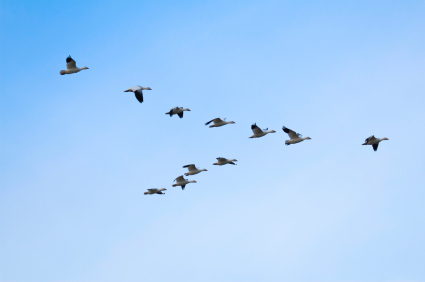 Driving to work in the morning the past several weeks, there have been occasional large flocks of geese and ducks flying . In the northern U.S. it’s time for the fall waterfowl migration south. In fact, the flock sizes have decreased in the past week, and several online sources concur that waterfowl migration has peaked, in mid December.
Driving to work in the morning the past several weeks, there have been occasional large flocks of geese and ducks flying . In the northern U.S. it’s time for the fall waterfowl migration south. In fact, the flock sizes have decreased in the past week, and several online sources concur that waterfowl migration has peaked, in mid December.
I grew up in eastern South Dakota, on what is known as the Central Flyway for waterfowl migration. As the designated dog walker in my family, I spent a 20-30 minute outing about 9pm each night with our Springer Spaniel. Honestly, during the cold late fall and winter months, this was sometimes more of a chore than it was a pleasure. However, the outing did hold its rewards. There was bonding time with the dog and the fact that she would be ready for her night indoors, and on those late fall nights, sometimes there was a chance to hear and see geese flying overhead.
Noticing the birds always started with the realization of a faint yet repeated sound. There weren’t a lot of people (or dogs) out in the cold after 9pm so I’d look around for a few seconds, wondering what the sound was, before realizing it was coming from overhead. I’d then start scanning the sky, listening and trying to decide where to look. On a cloudy night the light-colored undersides of the birds took some time to find against the grey color of the cloud bottoms, but if one was patient and kept listening, the ear would help the eye determine where to look, with the reward of a line of geese or ducks. The formations were usually quite high up, so the birds appeared very small, but the flock sizes were always amazing.
Back in those days I wasn’t aware of the type of geese flying over, but in later years have become interested in the snow geese and tundra swans that fly over our southern Wisconsin neighborhood, near the Mississippi Flyway.
We see Canada geese here regularly and are familiar with their calls. But late in the fall, usually around Thanksgiving, we’re sometimes surprised by a different call. And while I’m a waterfowl enthusiast, not an expert, I believe those calls to be either snow geese or tundra swans.
Here is what the snow goose sounds (and looks) like, courtesy of Cornell University’s Laboratory of Ornithology http://www.allaboutbirds.org/guide/snow_goose/sounds
And here the Tundra Swan: http://www.allaboutbirds.org/guide/Tundra_Swan/sounds.
Also, here is a Wikipedia page on general bird migration: http://en.wikipedia.org/wiki/Bird_migration
Happy bird watching. Let us know what you see or hear in your area!
Kari Kenefick
Latest posts by Kari Kenefick (see all)
- Cell-Based Target Engagement and Functional Assays for NLRP3 Inhibitor Profiling Help Identify Successes and Failures - January 25, 2024
- Illuminating the Brain with a New Bioluminescence Imaging Substrate - April 13, 2023
- Made Just for You: Promega Custom Reagents - October 28, 2022
